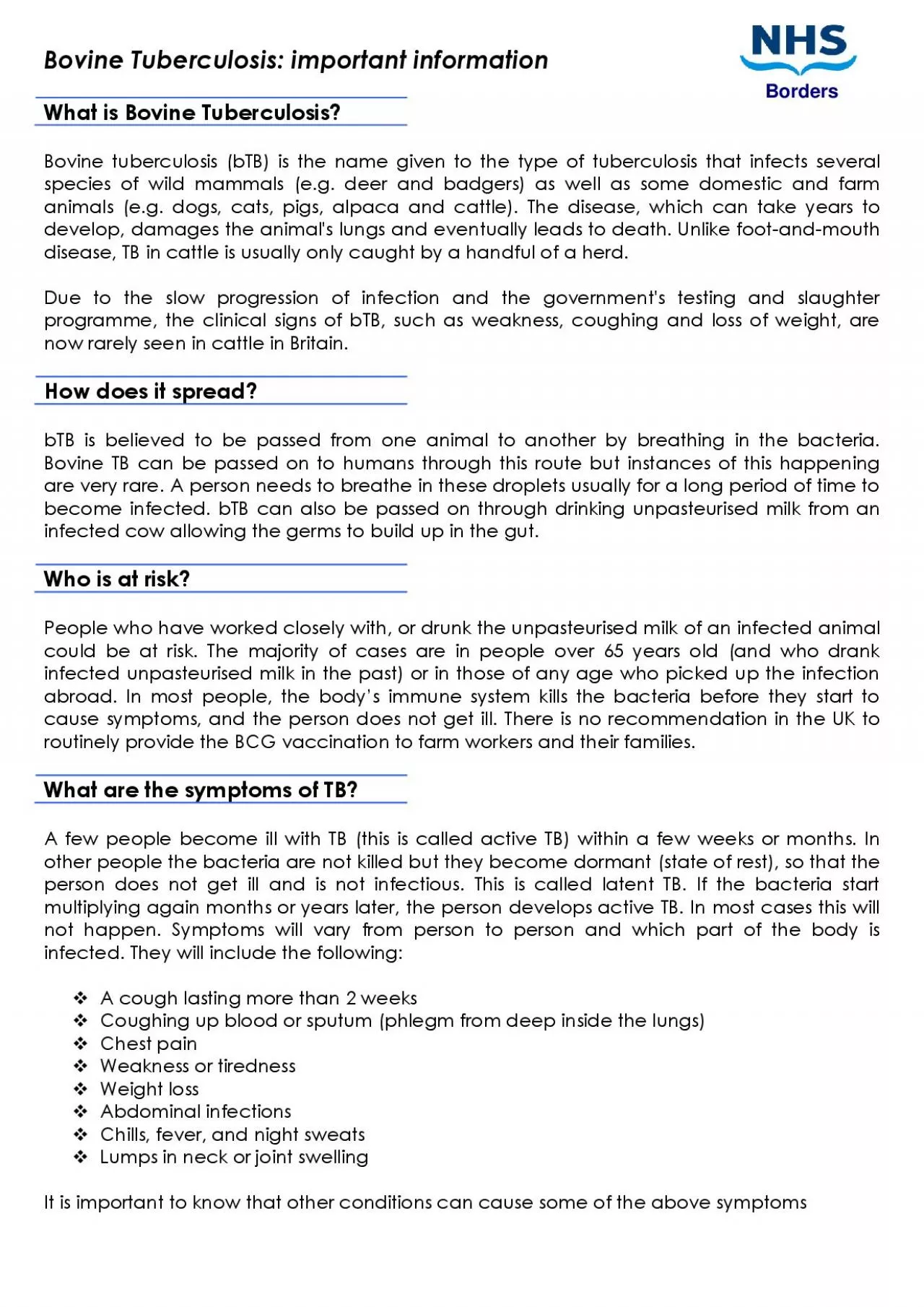

important information What is Bovine Tuberculosis Bovine tuberculosis bTB is the name given to the type of tuberculosis that infects several species of wild mammals eg deer and badgers as ID: 938102
Download Pdf The PPT/PDF document "Bovine Tuberculosis" is the property of its rightful owner. Permission is granted to download and print the materials on this web site for personal, non-commercial use only, and to display it on your personal computer provided you do not modify the materials and that you retain all copyright notices contained in the materials. By downloading content from our website, you accept the terms of this agreement.
Bovine Tuberculosis : important information What is Bovine Tuberculosis ? Bovine tuberculosis (bTB) is the name given to the type of tuberculosis that infects several species of wild mammals (e.g. deer and badgers) as well as some domestic and farm anima ls (e.g. dogs, cats, pigs, alpaca and cattle ) . The disease, which can take years to develop, damages the animal's lungs and eventually leads to death. Unlike foot - and - mouth disease, TB in cattle is usually only caught by a handful of a herd. Due to the s low progression of infection and the government's testing and slaughter programme, the clinical signs of bTB, such as weakness, coughing and loss of weight, are now rarely seen in cattle in Britain. How does it spread ? b TB is believed to be passed from one animal to another by breathing in the bacteria. Bovine TB can be passed on to humans through this route but instances of this happening are very rare. A person needs to breathe in these droplets usually for a long period of time to become infected. bTB can also be passed on through drinking unpasteurised milk from an infected cow allow ing the germs to build up in the gut. Who is at risk ? People who have worked closely with, or drunk the unpasteurised milk of an infected animal could be at risk. The m ajority of cases are in people over 65 years old (and who drank infected unpasteurised milk in the past) or in those of any age who picked up the infection abroad. In most people, the body’s immune system kills the bacteria before they start to cause sympt oms, and the person does not get ill. There is no recommendation in the UK to routinely provide the BCG vaccination to farm workers and their families. What are the symptoms of TB ? A few people become ill with TB (this is called active TB) within a few weeks or months. In other people the bacteria are not killed but they become dormant (state of rest) , so that the person does not get ill and is not infectious. This is called latent TB. If the bacteria start multiplying again months or years later, the pe rson develops active TB. In most cases this will not happen. Symptoms will vary from person to person
and which part of the body is infected. They will include the following: A cough lasting more than 2 weeks Coughing up blood or sputum (phlegm from deep inside the lungs) Chest pain Weakness or tiredness Weight loss Abdominal infections Chills, fever, and night sweats Lumps in neck or joint swelling It is important to know that other conditions can cause some of the above symptoms How is it detected ? One way to diagnose TB in the lungs is by examining the sputum unde r a microscope. A skin test (Mantoux ) can be done to see if a person has been exposed to TB in the past. The area is checked a few days later. If a large enough area of skin has become rais ed and reddened (called a positive result) this could mean you have latent TB. Further tests will need to be carried out as reddening can also have other causes. A chest x - ray can be helpful. For people thought to have TB in another part of the body, doc tors may take a small sample of tissue from the area (called a biopsy), or remove a few cells or fluid from the area using a needle. The sample will be checked to see if it contains TB bacteria. How is it treated ? In most cases, TB disease can be cured with anti - TB drugs. To work, the drugs must be taken exactly as prescribed. TB bacteria die very slowly. Medication must be taken for 6 months or longer. What do I need to do now ? Remember that the risk of getting bTB is very low. If you are concerned t hat you may have been exposed to bTB and have any of the above symptoms it is important that you seek medical advice. Need further advice or information? NHS Inform www.nhsinform.co.uk NHS24 111 www.nhs24.co.uk www.nhsborders.scot.nhs.uk Local health clinic or GP This document is available on request in different languages, audio tape, Braille format, large p rint or BSL DVD. Please contact: NHS Borders on 01896 825522 or email equality@borders.scot.nhs.uk Produced by: Public Health Dept, NHS Borders, Education Centre, Borders General Hospital, Melrose, TD6 9BD , 01896 825560 June 2014